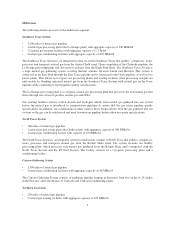Energy Transfer 2010 Annual Report Download - page 21
Download and view the complete annual report
Please find page 21 of the 2010 Energy Transfer annual report below. You can navigate through the pages in the report by either clicking on the pages listed below, or by using the keyword search tool below to find specific information within the annual report.Products, Services and Marketing
Our customer service locations are typically located in suburban and rural areas where natural gas is not readily
available. Such locations generally consist of a one to two acre parcel of land, an office, a small warehouse and
service facility, a dispenser and one or more 18,000 to 30,000 gallon storage tanks. Propane is generally
transported from refineries, pipeline terminals, leased storage facilities and coastal terminals by rail or truck
transports to our customer service locations where it is unloaded into storage tanks. In order to make a retail
delivery of propane to a customer, a bobtail truck, which generally holds 2,500 to 3,000 gallons of propane, is
loaded with propane from the storage tank. Propane is then delivered to the customer by the bobtail truck and
pumped into a stationary storage tank on the customer’s premises. We also deliver propane to retail customers in
portable cylinders and to certain other bulk end-users in tractor-trailer transports, which typically have an average
capacity of approximately 10,500 gallons. End-users receiving transport deliveries include industrial customers,
large-scale heating accounts, mining operations and large agricultural accounts.
We encourage our customers whose propane needs are temperature sensitive to implement a regular delivery
schedule. Many of our residential customers receive their propane supply pursuant to an automatic delivery
system, which eliminates the customer’s need to make an affirmative purchase decision and allows for more
efficient route scheduling. We also sell, install and service equipment related to our propane distribution
business, including heating and cooking appliances.
Of the retail gallons we sold in 2010, approximately 55% were to residential customers, 29% were to industrial,
commercial and agricultural customers and 16% were to other retail users. While sales to residential customers in
2010 accounted for 55% of total retail gallons sold, they accounted for approximately 68% of our gross profit
from propane sales. Residential sales have a greater profit margin and a more stable customer base than the other
markets we serve. Industrial, commercial and agricultural sales accounted for 20% of our gross profit from
propane sales for 2010, with all other retail users accounting for 12%. No single propane customer accounted for
10% or more of consolidated revenues in 2010.
Since home heating usage is the most sensitive to temperature, residential customers account for the greatest
usage variation due to weather. Variations in the weather in one or more regions in which we operate can
significantly affect the total volumes of propane that we sell and the margins realized thereon and, consequently,
our results of operations. We believe that sales to the commercial and industrial markets, while affected by
economic patterns, are not as sensitive to variations in weather conditions as sales to residential and agricultural
markets.
Propane Supply and Storage
Our supplies of propane historically have been readily available from our supply sources. We purchase from over
40 energy companies and natural gas processors at numerous supply points located in the United States and
Canada. In 2010, Enterprise Products Partners L.P. (together with its subsidiaries “Enterprise”) and Targa
Liquids Marketing and Trade (“Targa”) provided approximately 53.5% and 12.9% of our combined total propane
supply, respectively. Enterprise owns approximately 17.6% of the outstanding ETE common units. We purchase
a portion of our propane from Enterprise pursuant to an agreement that was extended until March 2015, and
includes an option to extend the agreement an additional year. Substantially all agreements with Targa have a
maximum duration of one year.
In addition, we have a propane purchase agreement with M.P. Oils, Ltd. to purchase not less than 90.0 million
gallons of propane that expires in 2015, which provided 13.3% of our combined total propane supply during
2010.
We believe that if supplies from Enterprise, Targa or M.P. Oils, Ltd. were interrupted, we would be able to
secure adequate propane supplies from other sources without a material disruption of our operations. No other
single supplier provided more than 10% of our total domestic propane supply during 2010. Although we cannot
19
























